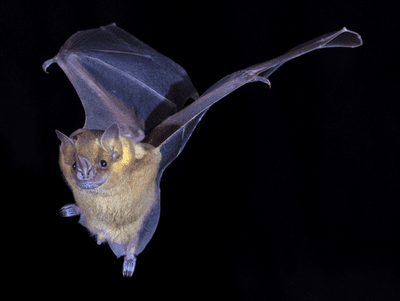ABOVE: Researchers produced the first complete genome sequences of the Jamaican fruit bat (Artibeus jamaicensis; shown here) and the Mesoamerican mustached bat (Pteronotus mesoamericanus) using long read sequencing. Brock and Sherri Fenton
While Batman may lack inborn superpowers, real bats have evolved numerous extraordinary adaptations, including flight, longevity, echolocation, low cancer rates, and robust immune systems.1-5 “All of those things make bats a really interesting model to add to the … model species that we have for humans,” said Armin Scheben, a postdoctoral fellow at Cold Spring Harbor Laboratory (CSHL). In a recent paper published in Genome Biology and Evolution, a group of CSHL researchers including Scheben, Adam Siepel, and Richard McCombie sequenced two important bat species to learn more about the genetics behind bat superpowers.6
Scientists consider bats to be pathogen reservoirs thanks to their immune systems that keep numerous viruses in check.7 “Bats are very social organisms that roost together, which will allow a virus to spread in their population,” said Scheben. When bats interact with other animals, these viruses can also spillover into new hosts. If a host’s immune system is not accustomed to a certain pathogen, the virus can cause disease and spread throughout a new population. There are numerous confirmed or suspected spillover events from bats to humans that led to dangerous outbreaks, including the Marburg virus and the first SARS outbreak.8,9 Bats may have also played a role in the COVID pandemic.10 Understanding bats’ antiviral immune responses could inform future infectious disease treatments.
In their recent paper, Scheben and his colleagues generated the first complete genome sequences of the Jamaican fruit bat (Artibeus jamaicensis), which is a mammalian model organism,11 and the Mesoamerican mustached bat (Pteronotus mesoamericanus). Collaborators at the American Museum of Natural History collected the bat samples from the Lamanai Archaeological Reserve in Belize before the researchers analyzed the genomes using long read sequencing. In contrast to common next generation sequencing methods that read only short nucleic acid fragments, long read sequencing produces lengthier sequences that encompass genomic features commonly missed in short read genome alignments, which are important for studying mammalian immune genes.12 "Immune genes are often tandem duplicated,” said Scheben. “We have one gene that takes care of a certain kind of pathogen response, but then you need to tweak it a little bit to be able to adapt to a new pathogen. So, it's handy to be able to copy it and then get some new function.”

See Also “Duplicated Gene Helps Bats Survive “Arms Race” With Viruses”
When comparing the newly sequenced bat genomes to other mammals, the researchers found that some immune gene families were expanded. However, they also detected numerous immune loci where duplicated genes were lost. The researchers’ most notable finding was the contraction of the type I interferon (IFN) locus, which includes antiviral genes.13 In most mammals, this region is large, containing many duplications. Here, the sequenced bats had lost most or all the genes that produce IFN-α. They hypothesized that this loss causes a greater reliance on IFN-ω genes, leading to a weaker inflammatory response and a stronger antiviral response. This strategy could control viral infections while preventing an immune response that is damaging to the host.
The researchers also observed positive selection for genes with cancer implications. “We found that there are a large number of these antitumor genes that are evolving rapidly, accumulating many bat-specific genetic changes,” said Scheben. These changes may be suppressing cancer in bats and could highlight mechanisms important in the cancer responses of other mammals. Some of these genes also contribute to the immune response, which highlights the interconnectedness of cancer and the immune system.
“What I really find intriguing is that different bats evolved to have specific mechanisms for controlling virus infections or dealing with DNA damage,” said Kevin Ciminski, junior leader of the bat influenza group at the University of Freiburg who wasn't involved in the study. “This is a very valuable resource for people working with bats, bat immunology, and also comparative immunology.”
See Also “Finally, Scientists Sequence Single Cells with Long-Read Technology”
With these new leads suggesting important factors for immune and cancer responses, Ciminski and Scheben agree that functional studies in mammalian systems are the next step. “We think these leads can be very useful after further experimental validation … to understand how bats may be able to resist viral infections,” said Scheben. “Some of the leads that we've generated in the long run could contribute to the development of new therapeutics for human health in the treatment of cancer and viral infections.”
References
- Simmons NB, et al. Primitive early Eocene bat from Wyoming and the evolution of flight and echolocation. Nature. 2008;451(7180):818-821.
- Wilkinson GS, Adams DM. Recurrent evolution of extreme longevity in bats. Biol Lett. 2019;15(4):20180860.
- Moss CF, Surlykke A. Auditory scene analysis by echolocation in bats. J Acoust Soc Am. 2001;110(4):2207-2226.
- Koh J, et al. ABCB1 protects bat cells from DNA damage induced by genotoxic compounds. Nat Commun. 2019;10(1):2820.
- Pavlovich SS, et al. The Egyptian Rousette genome reveals unexpected features of bat antiviral immunity. Cell. 2018;173(5):1098-1110.e18.
- Scheben A, et al. Long-read sequencing reveals rapid evolution of immunity- and cancer-related genes in bats. Genome Biol Evol. 2023;15(9):evad148.
- Olival KJ, et al. Host and viral traits predict zoonotic spillover from mammals. Nature. 2017;546(7660):646-650.
- Amman BR, et al. Seasonal pulses of Marburg virus circulation in juvenile Rousettus aegyptiacus bats coincide with periods of increased risk of human infection. PLOS Pathogens. 2012;8(10):e1002877.
- Li W, et al. Bats are natural reservoirs of SARS-like coronaviruses. Science. 2005;310(5748):676-679.
- Lytras S, et al. Exploring the natural origins of SARS-CoV-2 in the light of recombination. Genome Biol Evol. 2022;14(2):evac018.
- Larsen PA, et al. Phylogenetics and phylogeography of the Artibeus jamaicensis complex based on cytochrome-b DNA sequences. J Mammal. 2007;88:712–727.
- O’Connor EA, Cornwallis CK. Immunity and lifespan: answering long-standing questions with comparative genomics. Trends Genet. 2022;38(7):650-661.
- McNab F, et al. Type I interferons in infectious disease. Nat Rev Immunol. 2015;15(2):87-103.







